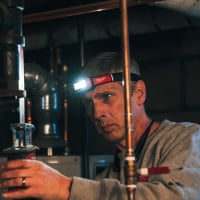Hot water cast iron radiator not heating
Hi, can anyone advise me on how to proceed. The plumber disconnected the radiator form the input and output valve bled the system that repeatingly. They also kept feeding it water from the furnace. They other radiators are working fine. Can anyone assist me in determing the problem. The plumber says to get a new radiator which I do not agree with.
Thanks in advance
Comments
-
Disconnected the radiator? Eh? Radiator is likely airbound. Question is, how to purge the air from it…
First, is there a bleed valve on the radiator? Top of one end or the other. With the valves to the system open and the pressure good, open that — should get good stream of water; leave it open until you do.
If that does it, lovely. If it doesn't, the system needs to be purged. Any idea how it is piped? Picture, maybe?
Br. Jamie, osb
Building superintendent/caretaker, 7200 sq. ft. historic house museum with dependencies in New England0 -
-
here is the pic. How much pressure should the furnace be should we raise the it? We already opened the bleed valve
0 -
0
-
-
Why was the radiator disconnected?
Is that valve 100% open?
Were there any piping changes to the system?
If so that could very well be the issue…
typical system like that runs at about 15 psi.
0 -
how is it plumbed in the basement? is it separate supply and return mains or is it monoflo or home run or something?
0 -
Is this radiator on the highest floor in the house by any chance? The height above the boiler affects the pressure you need to maintain in the system to get the water to the top.
—
Bburd0 -
X-2
0 -
-
The radiator was removed and reinstalled to install new floors. Then there was a leak, called different plumber who said leak was fixed paid him and it has not worked since. The valve and feed elbow we’re changed.
There are 2 radiators connected to that feed. The other radiator is working.
0 -
Is the valve open?
0 -
it on the second floor but it is not the furthest from the furnace other rads are further away and working fine. Only attic above.
0 -
Is the gold part called a union? If yes that part is pressured not saudered. We think that part is incorrect but plumber said it is.
0 -
The spud is the part that screws in to the radiator that mates with the valve. the part of the spud and valve that go together with the nut is called a union. It is to allow the piping to be taken apart. It doesn't need to be doused in dope and teflon tape but is unlikely to be the cause of your lack of flow. That spud should have come with the valve, they aren't standardized so it need to be the part that came with that manufacturer's valve, but if it were wrong it would leak, not prevent flow. If you open the bleeder, does water come out?
since that copper pipe is very unlikely to be original, i wonder what else was done.
0 -
-
go to
Find a contractor on this site.
0 -
When you open the bleeder on the non working radiator 1 of three things will happen:
1 you get nothing
2 you get water
3 you get air.
If you want help you have to answer the questions.
What floor is the problem radiator on and how much water pressure is in the boiler?
0 -
been there. You likely have a “bubble” in the run out piping. Pretty difficult to diagnose over the phone screen
0 -
This is from another section "off the wall" You prob have a converted gravity system…
Swapping out the valve may have messed w/ the pressure drop…
0 -
when bleeder is open we get water and air bubbles
0 -
the gages on furnace read 150 and 50. Radiator is on the second floor. If air bubble is the issue how can it be resolved.
0 -
-
Stupid question, did this radiator heat prior to removal?
0
Categories
- All Categories
- 87.3K THE MAIN WALL
- 3.2K A-C, Heat Pumps & Refrigeration
- 61 Biomass
- 427 Carbon Monoxide Awareness
- 119 Chimneys & Flues
- 2.1K Domestic Hot Water
- 5.8K Gas Heating
- 115 Geothermal
- 165 Indoor-Air Quality
- 3.7K Oil Heating
- 76 Pipe Deterioration
- 1K Plumbing
- 6.5K Radiant Heating
- 395 Solar
- 15.6K Strictly Steam
- 3.4K Thermostats and Controls
- 56 Water Quality
- 51 Industry Classes
- 50 Job Opportunities
- 18 Recall Announcements







